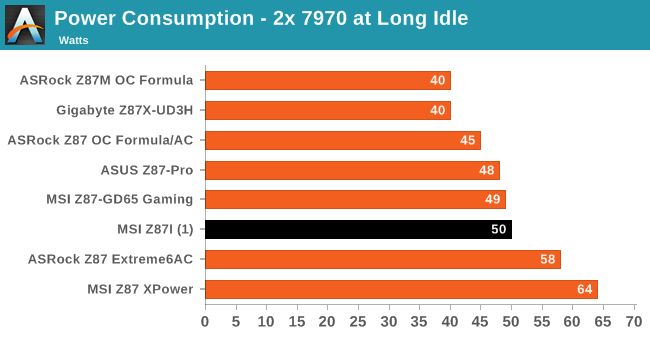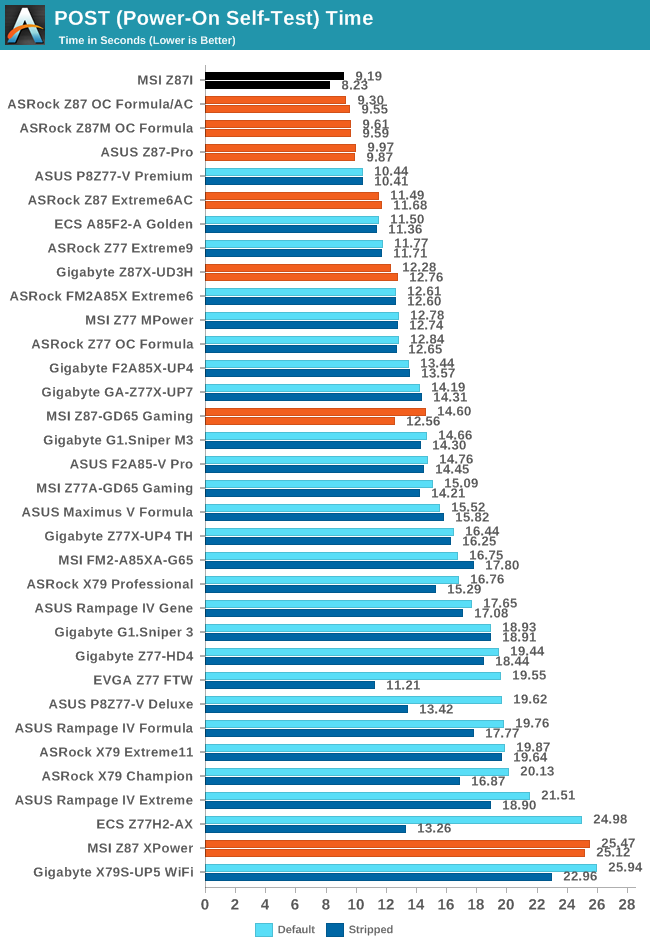MSI Z87I Review: Mini-ITX Haswell for $140
by Ian Cutress on August 27, 2013 10:15 AM EST- Posted in
- Motherboards
- MSI
- Mini ITX
- Z87
Many thanks to...
We must thank the following companies for kindly providing hardware for our test bed:
Thank you to OCZ for providing us with 1250W Gold Power Supplies.
Thank you to G.Skill for providing us with memory kits.
Thank you to Corsair for providing us with an AX1200i PSU, Corsair H80i CLC and 16GB 2400C10 memory.
Thank you to ASUS for providing us with the AMD GPUs and some IO Testing kit.
Thank you to ECS for providing us with the NVIDIA GPUs.
Thank you to Rosewill for providing us with the BlackHawk Ultra, and 1600W Hercules PSU for extreme dual CPU + quad GPU testing, and RK-9100 keyboards.
Thank you to ASRock for providing us with the 802.11ac wireless router for testing.
Test Setup
| Processor |
Intel Core i7-4770K Retail 4 Cores, 8 Threads, 3.5 GHz (3.9 GHz Turbo) |
| Motherboards |
ASRock Z87 Extreme6/AC ASRock Z87 OC Formula/AC ASRock Z87M OC Formula ASUS Z87-Pro Gigabyte Z87X-UD3H MSI Z87-GD65 Gaming MSI Z87 XPower MSI Z87I |
| Cooling |
Corsair H80i Thermalright TRUE Copper |
| Power Supply |
OCZ 1250W Gold ZX Series Corsair AX1200i Platinum PSU |
| Memory |
GSkill TridentX 4x4 GB DDR3-2400 10-12-12 Kit Corsair Vengeance Pro 2x8 GB DDR3 2400 10-12-12 Kit |
| Memory Settings | XMP (2400 10-12-12) |
| Video Cards |
ASUS HD7970 3GB ECS GTX 580 1536MB |
| Video Drivers |
Catalyst 13.1 NVIDIA Drivers 310.90 WHQL |
| Hard Drive | OCZ Vertex 3 256GB |
| Optical Drive | LG GH22NS50 |
| Case | Open Test Bed |
| Operating System | Windows 7 64-bit |
| USB 2/3 Testing | OCZ Vertex 3 240GB with SATA->USB Adaptor |
| WiFi Testing | D-Link DIR-865L 802.11ac Dual Band Router |
Power Consumption
Power consumption was tested on the system as a whole with a wall meter connected to the OCZ 1250W power supply, while in a dual 7970 GPU configuration. This power supply is Gold rated, and as I am in the UK on a 230-240 V supply, leads to ~75% efficiency > 50W, and 90%+ efficiency at 250W, which is suitable for both idle and multi-GPU loading. This method of power reading allows us to compare the power management of the UEFI and the board to supply components with power under load, and includes typical PSU losses due to efficiency. These are the real world values that consumers may expect from a typical system (minus the monitor) using this motherboard.
While this method for power measurement may not be ideal, and you feel these numbers are not representative due to the high wattage power supply being used (we use the same PSU to remain consistent over a series of reviews, and the fact that some boards on our test bed get tested with three or four high powered GPUs), the important point to take away is the relationship between the numbers. These boards are all under the same conditions, and thus the differences between them should be easy to spot.

While at the low end of our PSU efficiency, the readings for the Z87I at long idle are higher than expected compared to full sized ATX motherboards. At normal idle however, the MSI is efficient – similarly during CPU loading. As the Z87I is a mini-ITX motherboard, we can only test with one GPU installed, explaning the difference in results for a gaming load.
Windows 7 POST Time
Different motherboards have different POST sequences before an operating system is initialized. A lot of this is dependent on the board itself, and POST boot time is determined by the controllers on board (and the sequence of how those extras are organized). As part of our testing, we are now going to look at the POST Boot Time - this is the time from pressing the ON button on the computer to when Windows 7 starts loading. (We discount Windows loading as it is highly variable given Windows specific features.) These results are subject to human error, so please allow +/- 1 second in these results.

I am glad to see another motherboard POST less than 10 seconds in our test, although mini-ITX motherboards have the advantage in this test by only dealing with one discrete GPU compared to two used in other motherboards).










46 Comments
View All Comments
Meaker10 - Wednesday, August 28, 2013 - link
No they are not, while the devices will plug into both slots, a mSATA drive will not work in a mini PCI-E slot and a mini PCI-E card will not work in an mSATA slot meaning they are physically compatible but not electrically compatible.There are a few SSDs that have a SATA to PCI express bridge and these will only work in mini pci express slots and wont be bootable.
Jason33 - Wednesday, August 28, 2013 - link
mSATA and mPCIe are electrically compatible. You only need to mux the data signals on the motherboard to either go to the SATA controller or the PCIe controller.Using this mux chip on the motherboard would work: http://www.nxp.com/documents/application_note/AN11...
Meaker10 - Thursday, August 29, 2013 - link
Yes they are compatible with a MUX, so how is that going to help with an mSATA/PCI-E slot that is not muxed?I have yet to see a consumer device with that muxed in so it's a pointless argument to make.
Jason33 - Thursday, August 29, 2013 - link
Several ThinkPads and notebooks for a few years now have done this. I'm running an mSATA drive in my ThinkPad that used to have a mPCIe WWAN card. There are also mini motherboards that can accept either type of card.Jason33 - Friday, August 30, 2013 - link
Also, I do agree that slots that don't have a mux will only allow one type of card. However, most consumer boards, notebooks and pre-built systems I've personally encountered that support mSATA cards also support mPCIe cards for the same slot.To answer kwrzesien's original question, MSI doesn't advertise it as supporting mSATA. If it did, they'd definitely say so. No reason to not advertise a feature. If you really want a Z87 ITX board with an mSATA slot then the ASRock Z87E-ITX has a full height mSATA/mPCIe slot in addition to the half height mPCIe slot holding the 802.11ac WiFi module.
1Angelreloaded - Thursday, August 29, 2013 - link
You are right and wrong, MSATA was initially made to use as a caching flash for Laptop hardrives, an MSATA port is different from MPCIe look at the combo card Asus gives in its ROG series Mobos, trust me they are incompatible.1Angelreloaded - Thursday, August 29, 2013 - link
No different channel slot type , do yourself the favor pay 50$ more and get the Asus Maximus Impact, much better.DanNeely - Tuesday, August 27, 2013 - link
Something's not consistent here:6 x USB 3.0 (Chipset) [4 back panel, 1 header]
4 x USB 2.0 (Chipset) [2 back panel, 2 header]
Assuming the totals are correct you're counting USB3 headers on one line, and USB2 ports from headers on the second.
IanCutress - Tuesday, August 27, 2013 - link
Ah yes, I normally have a header equal to two ports unless otherwise stated. Table is fixed.Ian
The Von Matrices - Tuesday, August 27, 2013 - link
Unfortunately a few of the motherboard articles posted in the past few weeks are incorrect regarding the Flex IO configuration. In this article, it states "This amount of extra network controllers is due to the Flex IO allocation – as the board only has four SATA 6 Gbps and six USB 3.0 from the chipset, this gives the other 8 Flex IO lanes all the PCIe 2.0 for these controllers." However, the Flex I/O allocation in the specifications table states that there are 6/4/8 SATA/USB 3/PCIe 2.Similarly, the review of the ASRock Z87 Extreme6/AC is incorrect in this regard as well. It states that "Out of our total 18 PCH Flex IO ports on board, this means we have six for SATA 6 Gbps ports, we also have four for USB 3.0 (PCH are headers, ASMedia on Rear IO) leaving eight for PCIe 2.0 lanes." I own a Z87 Extreme6, and I can tell you that this is not correct. The Flex I/O allocation in this board is 6/6/6 SATA/USB 3/PCIe 2. The rear USB 3.0 ports are driven by an ASMedia ASM1074 USB hub, not an ASMedia PCIe USB 3 controller, as would be implied by the Flex IO table in the article.